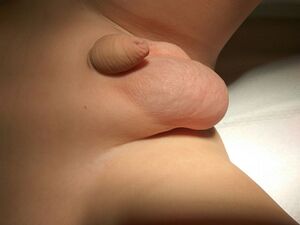Hydrocele
Hydrocele is a common condition in which clear amber fluid collects between the membranes of the testicle. The fluid is in the cavum serosum scroti , between the parietal and visceral sheets of the tunica vaginalis testis . Less common is hydrocele of the spermatic cord ( funiculocele ).
Division and causes[edit | edit source]
Congenital hydrocele can be found in children, the cause of which is unknown. The finding can be further divided into non-communicating and communicating hydrocele. In the latter case, the processus vaginalis peritonei is not closed , so there is free communication between the cavum scroti and the abdominal cavity. This type may be associated with an indirect inguinal hernia.
Primary hydrocele is the type that develops in adulthood. The cause is probably an imbalance between fluid production and resorption, but the triggering factor is unknown.
Secondary hydrocele arises as a reaction to another pathological process of the testicle or epididymis. It can occur, for example, with inflammation or after an injury.
Clinical picture[edit | edit source]
Hydrocele is manifested by an increase in the contents of the scrotum, the patient is usually without problems. It is most often discovered during self-examination or as an incidental finding during a physical examination. The asymptomatic course of the disease is typical , but sometimes the patient may complain of feelings of pressure and heaviness ..
Diagnostics and differential diagnosis[edit | edit source]
The basis for diagnosis is the anamnesis, the patient reports gradual enlargement of the scrotum. In the objective finding, there is a painless, elastic, enlarged hemiscrotum, the finding can also be bilateral. When transilluminating the scrotal sac, we can distinguish a hydrocele from a contracted scrotal hernia.
Of the imaging methods, the first choice is an ultrasound examination. In case of uncertainty, we can perform a hydrocele puncture. This will obtain fluid for cytological and microbiological examination, and the testicles with the epididymis are subsequently more accessible for palpation.
A funiculocele is characterized by the finding of a spindle-shaped thickening that leads through the groin to the upper part of the scrotum.
In boys with congenital communicating hydrocele, we can note in the anamnesis that the scrotum is smaller and softer in the morning hours, during the day the scrotum enlarges, the skin is more tense.
A rapidly developing hydrocele may be related to scrotal injury, infection or radiotherapy the area.
In the differential diagnosis, we must differentiate between inflammatory and tumorous diseases, spermatocele. It is also important to distinguish a secondary hydrocele, which can be the first manifestation of a tumor affection.
Therapy[edit | edit source]
For a patient with hydrocele, we choose from several procedures. If it is a smaller asymptomatic hydrocele, we just monitor the patient.
Symptomatic hydrocele can be punctured. The procedure brings temporary relief, the fluid in the bag will be restored in a short time. It is therefore not a definitive solution to the disease.
Definitive treatment is surgery. We choose it for symptomatic hydrocele, which causes pain or discomfort to the patient. The goal of the procedure is to create communication between the scrotal cavity and the subcutaneous tissue, which resorbs the fluid.
We perform the procedure under general or spinal anesthesia. First, we make an incision on the relevant side of the scrotum, then open the scrotal sac and drain the fluid. In order to prevent recurrences, we resect as much of the bag as possible, sew the remaining edges with an absorbable suture and continue with suturing the surgical wound.[1].
A communicating hydrocele usually closes spontaneously before the first year of age. We approach the surgical solution if the hydrocele persists even after the second year of age or if we distinguish intestinal loops in the scrotum.
Links[edit | edit source]
Related Articles[edit | edit source]
External links[edit | edit source]
- Urologie pro studenty: Hydrokéla
- Česká urologická společnost ČLS JEP: Onemocnění varlat
- Medicína, nemoci, studium na 1. LF UK: Hydrokéla
References[edit | edit source]
Recommended reading[edit | edit source]
- KAWACIUK, Ivan. Urologie. 1. edition. Galén, 2009. 531 pp. pp. 469, 470. ISBN 978-80-7262-627-7.
Recommended reading[edit | edit source]
- HANUŠ, Tomáš – MACEK, Petr. Urologie pro mediky. 1. edition. 2015. 305 pp. pp. 214. ISBN 9788024630083.


